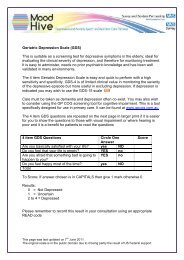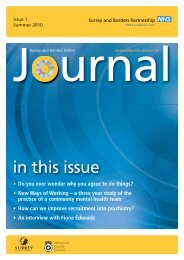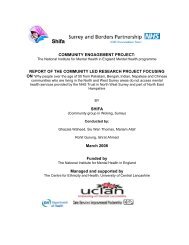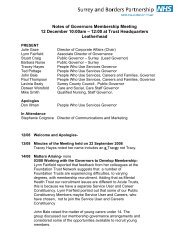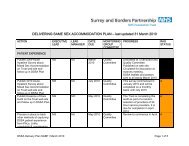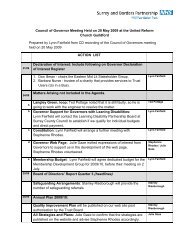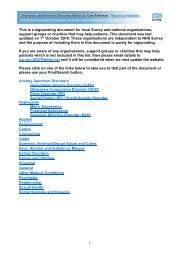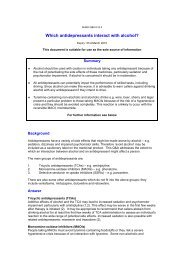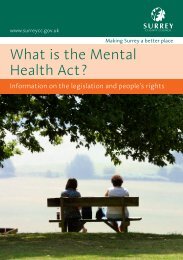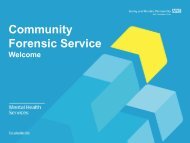Medicines Q&As
Medicines Q&As
Medicines Q&As
Create successful ePaper yourself
Turn your PDF publications into a flip-book with our unique Google optimized e-Paper software.
<strong>Medicines</strong> Q&<strong>As</strong><br />
Q&A 24.3<br />
What is the most appropriate antidepressant to use in epileptics?<br />
Prepared by UK <strong>Medicines</strong> Information (UKMi) pharmacists for NHS healthcare professionals<br />
Expiry: 31 st March 2010<br />
Background<br />
The prevalence of epilepsy in the general population has been suggested to be 0.5-5% (1). Patients<br />
with epilepsy are prone to depression and the incidence rates quoted in the literature range from 20 to<br />
55% (2), which are significantly higher than in the general population (1-9%) (3). A higher incidence<br />
of depression is estimated in patients with severe epilepsy, 50-55% (4), whilst a lower incidence is<br />
estimated in those patients with controlled epilepsy, 3-9% (1). The use of antidepressant medication<br />
in patients with epilepsy is a common clinical dilemma, as most antidepressants, especially the<br />
tricyclic antidepressants (TC<strong>As</strong>), are well known to lower the seizure threshold. It is important to treat<br />
depression in patients with epilepsy as they have attempted suicide rates three to five times higher<br />
than that of the general population (2).<br />
Answer<br />
Most antidepressants can lower the seizure threshold, and precipitate epileptic seizures (1;5).<br />
Antidepressants may exert proconvulsive effects by antagonising the actions of GABA (gamma<br />
amino-butyric acid), an inhibitory neurotransmitter in the brain that suppresses seizure activity. At<br />
therapeutic dosages, seizures are a rare but serious complication of antidepressant therapy (6). Data<br />
for the pro-convulsant effect of antidepressants comes largely from overdose studies (4;6). There is a<br />
lack of human data on the pro-convulsant effects of antidepressants at therapeutic doses and even<br />
less data in patients with epilepsy.<br />
Tricyclic Antidepressants (TC<strong>As</strong>)<br />
All TC<strong>As</strong> appear to lower the seizure threshold (7). Seizures have been reported in patients treated<br />
with TC<strong>As</strong> for depression, both with and without a past history of epilepsy at both therapeutic and<br />
toxic doses (6). The overall incidence of seizures at therapeutic doses of TC<strong>As</strong> has been estimated<br />
as being between 3-4% (8;9) though the incidence for individual TC<strong>As</strong> varies markedly (see Table 1).<br />
The incidence of seizures following TCA overdose has been reported to be between 3-41% (10).<br />
Table 1: Seizure incidence rates and manufacturers advice for individual TC<strong>As</strong>.<br />
Drug Incidence Manufacturers Advice<br />
Amitriptyline 0.3% (therapeutic doses) (6;11).<br />
Clomipramine<br />
1.0-12.2% (therapeutic doses,<br />
dose dependent) (11).<br />
Use with caution in patients with history of epilepsy<br />
(12).<br />
Use with extreme caution in epilepsy (13).<br />
Dosulepin Limited data. Avoid in patients with history of epilepsy (14).<br />
Doxepin 0.1% (therapeutic doses) (3).<br />
Imipramine<br />
Lofepramine<br />
Nortriptyline<br />
Trimipramine<br />
0.1% (≤200mg/day) – 1.1%<br />
(>200mg/day) (3;10;16).<br />
Limited data<br />
Limited data<br />
Limited data<br />
Use with caution in patients with history of epilepsy<br />
(15).<br />
Use with extreme caution in epilepsy (seizure<br />
occurrence appears to be dose dependent) (17).<br />
Use with extreme caution in patients with a history<br />
of epilepsy or recent convulsions (18).<br />
Avoid if possible in patients with a history of<br />
epilepsy (19).<br />
Avoid if possible in patients with a history of<br />
epilepsy (20).<br />
From the National Electronic Library for <strong>Medicines</strong>. www.nelm.nhs.uk 1
<strong>Medicines</strong> Q&<strong>As</strong><br />
Doxepin is considered to have the lowest incidence of seizures (5;7;9;21) and therefore is considered<br />
the TCA of choice. The manufacturers of amitriptyline and clomipramine have advised that these<br />
antidepressants should be used with caution in epilepsy but other sources recommend that they<br />
should be avoided completely in epilepsy (22).<br />
Selective Serotonin Reuptake Inhibitors (SSRIs)<br />
In general, the SSRIs have been suggested to have a low pro-convulsive effect (7;22), a favourable<br />
side effect profile and to be less problematic in overdose (6). SSRIs are associated with a lower<br />
incidence of seizures when compared with TC<strong>As</strong> (1;11). However, little data are available<br />
concerning the use of SSRIs in patients with epilepsy. Early clinical trials suggested that the SSRIs<br />
were not associated with seizures (6). Seizures have now been reported with all SSRIs (16) and the<br />
risk is considered to be dose related (22). Data on how these antidepressants induce seizures is still<br />
controversial, one theory is that a decreased turnover of serotonin in the central nervous system<br />
(CNS) might be associated with seizures (23). There is some evidence that SSRIs increase the<br />
seizure duration once a seizure has commenced (6).<br />
Fluoxetine is the most studied SSRI and was suggested to exert an anticonvulsant effect in rats, this<br />
has been further supported by data from small-scale controlled studies in humans (23). Fluoxetine<br />
has a probable seizure incidence of 0.2% (7;11;16) and has a long half-life (24). The manufacturers<br />
recommend it should be avoided in patients with unstable seizure disorders and patients with<br />
controlled epilepsy should be monitored (24).<br />
One small-scale study (n=28) reported that fluvoxamine was not epileptogenic at doses ranging from<br />
50 to 200mg, when given to depressed epileptic patients (25) however there have been case reports<br />
of seizures following therapeutic doses of fluvoxamine in patients with and without a previous history<br />
of seizures (26). More recently, a retrospective survey of prescriptions (n=10,401) suggested the<br />
incidence of seizure with fluvoxamine to be 0.2% in the general population (27). It has also been<br />
suggested that fluvoxamine is associated with a higher incidence of seizures in overdose when<br />
compared to other SSRIs but the evidence for this is poor (6). Fluvoxamine should be avoided in<br />
patients with unstable epilepsy and patients with controlled epilepsy should be carefully monitored<br />
(28).<br />
Paroxetine appears to have a minimal potential for producing seizures at therapeutic doses (7) but<br />
the manufacturers suggest that it should be used with caution in patients with epilepsy (29). Reviews<br />
suggest paroxetine has a seizure incidence of 0.1% (6;11;30). Seizures have occurred rarely in trials<br />
and no cause-effect relationship has been proven (7).<br />
Citalopram and escitalopram have not been reported to have a pro-convulsive effect (7). In a recent<br />
open label study citalopram 20mg/day was associated with an improvement in depressive symptoms<br />
and a reduction in seizure frequency in 39 patients who had epilepsy and depression (31). A study of<br />
43 patients with epilepsy showed citalopram to be an effective antidepressant without affecting<br />
seizure frequency (32). It is considered one of the first line options due to it is perceived safety in<br />
these patients and lack of interactions with the anticonvulsant agents (11;22) .<br />
Early clinical trials with sertraline suggested that seizures occurred at a similar frequency to placebo<br />
and only in people with a history of seizures (7). The above study in 43 patients showed only 6% of<br />
epileptics taking sertraline had worsening of seizures, which were corrected by adjusting the<br />
antiepileptic dosage (4;32).<br />
Overall, it has been suggested that the risk of seizures with SSRIs at therapeutic doses lies between<br />
0.1-4% (23) but the incidence varies between individual agents. SSRIs are considered the first line<br />
antidepressant option in patients with epilepsy (3;4;11;22;27). Fluoxetine, fluvoxamine and paroxetine<br />
are all potent inhibitors of the cytochrome P450 enzymes (11;22), which means they have interaction<br />
potential with the anticonvulsant agents, which needs to be considered. Citalopram and sertraline<br />
may be considered the safest options due to their lack of interaction potential with the anticonvulsants<br />
(11). The manufacturers of these agents recommend to avoid their use in patients with unstable<br />
epilepsy (33;34).<br />
From the National Electronic Library for <strong>Medicines</strong>. www.nelm.nhs.uk 2
<strong>Medicines</strong> Q&<strong>As</strong><br />
Monamine Oxidase Inhibitors (MAOIs)<br />
MAOIs have for many years been considered to be the least pro-convulsive antidepressants for<br />
patients with epilepsy (6;32). However MAOIs are seldom used now due to their interactions with<br />
certain foods and drugs and the fact that there are safer alternatives available. Moclobemide is a<br />
reversible inhibitor of monoamine oxidase type A (RIMA) which is less likely to interact with foods and<br />
drugs, and is associated with a low incidence of seizures in patients with depression (6). It is<br />
considered a good choice in patients with epilepsy and is not cautioned or contraindicated in these<br />
patients (22;35).<br />
Lithium<br />
Evidence suggests that lithium can reduce the seizure threshold but no studies have been conducted<br />
in patients with epilepsy. Animal studies suggest that prolonged lithium therapy may reduce seizure<br />
threshold (6). It is known that toxic serum levels of lithium are associated with seizures and the<br />
majority of reports have described seizures that are transient but some have persisted (6). Lithium<br />
has been thought to induce EEG abnormalities though data is conflicting (6;11). Encephalopathy or<br />
severe brain oedema can occur in patients taking lithium who have a seizure (6;11). At therapeutic<br />
doses it is considered to have a low pro-convulsive effect or have no effect on the seizure threshold<br />
(7;22).<br />
Miscellaneous Antidepressants<br />
Mianserin has a relatively low incidence of seizures compared to TC<strong>As</strong> at therapeutic doses in<br />
patients with brain damage, and following an overdose (6). It is often quoted as being relatively safe in<br />
epilepsy (7) however the manufacturers recommend to avoid if possible in patients with epilepsy (36).<br />
The incidence of seizures quoted in the literature for trazodone (a serotonin agonist) is
<strong>Medicines</strong> Q&<strong>As</strong><br />
In addition, some antidepressants may interact with anticonvulsants; this potential for interactions<br />
would need to be considered when choosing a suitable antidepressant agent for the patient. Plasma<br />
concentrations of the anticonvulsants should be carefully monitored if appropriate, particularly during<br />
the early phase of treatment with the antidepressant and doses adjusted accordingly (6;11;22).<br />
<strong>As</strong> a general rule, the more sedating a drug is, the more likely it is to induce seizures (22). There is a<br />
dose dependent relationship between antidepressant use and seizures. Patients should be<br />
commenced on a low dose, and this should be increased slowly until a therapeutic dose has been<br />
achieved, to reduce the risk of seizures (7;22). In addition, maximum recommended doses of<br />
antidepressants should not be exceeded.<br />
Summary<br />
• The first consideration should always be to check the patients’ anticonvulsant regimen for<br />
potential drug-induced depression. It may be that the patient would benefit from changing the<br />
anti-convulsant to another agent with a more favourable effect on mood rather than adding in<br />
an antidepressant.<br />
• The risk of seizures with most antidepressants is low, but is probably not zero for any of them,<br />
and patients should be made aware of this when prescribing. The risk of seizures increases<br />
with increasing doses.<br />
• SSRIs are considered the first line antidepressant option in patients with epilepsy. Published<br />
data do not support the recommendation of a specific SSRI, although fluoxetine is not the<br />
best choice due to its long half-life, a possibly greater incidence of seizures and an increased<br />
risk of drug interactions. Citalopram or sertraline may be considered the better option due to<br />
safety and reduced interaction potential with the anticonvulsants.<br />
• Moclobemide, is a good alternative, as it has a low incidence of seizures but due to limited<br />
data it should be reserved as a second choice.<br />
• TC<strong>As</strong> should be used cautiously in patients with epilepsy and reserved for patients who<br />
poorly respond to or are intolerant of other antidepressants. Where a TCA is needed, doxepin<br />
would be the agent of choice.<br />
• Clinicians should be aware of the possibility of interactions between antidepressants and<br />
anticonvulsants and should monitor carefully patients with epilepsy who are prescribed<br />
antidepressants.<br />
• Introducing the antidepressant gradually, starting with a low dose, and not exceeding the<br />
maximum recommended doses may reduce the risk of a seizure.<br />
Limitations<br />
In general, very little specific information is available about the use of antidepressants in epilepsy.<br />
Most studies investigating the relationship between antidepressants and seizure activity have<br />
examined the effects of antidepressants in overdose in the general population, making it difficult to<br />
extrapolate the findings to patients with epilepsy. Seizure rates quoted are based on the incidence in<br />
patients with depression rather than patients with epilepsy, and this latter figure would be expected to<br />
be higher. Many of the early estimates of seizure incidence were based on case reports where there<br />
were many influencing variables and poor definitions for what constituted a convulsive event.<br />
Patients were also often taking concomitant medication, which may have affected seizure threshold,<br />
or, through inhibition of antidepressant metabolism, caused higher antidepressant plasma levels.<br />
Newer antidepressants have undergone clinical trials with improved methodology and with systematic<br />
reporting of adverse events. However, even these do not allow accurate comparisons to be made<br />
between the antidepressants. There are few systematic studies of antidepressants in people with<br />
epilepsy. Unless a large-scale trial is conducted, which is unlikely, the best antidepressant in epilepsy<br />
will remain unknown (7).<br />
From the National Electronic Library for <strong>Medicines</strong>. www.nelm.nhs.uk 4
<strong>Medicines</strong> Q&<strong>As</strong><br />
Disclaimer<br />
♦ <strong>Medicines</strong> Q&<strong>As</strong> are intended for healthcare professionals and reflect UK practice.<br />
♦ Each Q&A relates only to the clinical scenario described.<br />
♦ Q&<strong>As</strong> are believed to accurately reflect the medical literature at the time of writing.<br />
♦ See NeLM for full disclaimer.<br />
References<br />
(1) Seethalakshmi R, Krishnamoorthy ES. Depression in epilepsy: phenomenology,diagnosis and<br />
management. Epileptic disorders 2007; 9(1):1-10.<br />
(2) Thome-Souza MS, Kuczynski E, Valente KD. Sertraline and fluoxetine: Safe treatments for<br />
children and adolescents with epilepsy and depression. Epilepsy and Behaviour 2007;<br />
10:417-425.<br />
(3) Anon. Prompt diagnosis and treatment of depression in patients with epilepsy essential for<br />
patient well-being. Drugs and Therapy Perspectives 2003; 19(1):7-10.<br />
(4) Jackson MJ, Turkington D. Depression and Anxiety in Epilepsy. Journal of Neurology<br />
Neurosurgery and Psychiatry 2005; 76((Suppl 1)):i45-i47.<br />
(5) Dudra-Jastrzebska M, Andres-Mach MM, Luszczki JJ et al. Mood disorders in patients with<br />
epilepsy. Pharmacological Reports 2007; 59:369-378.<br />
(6) Curran S, de Pauw K. Selecting an antidepressant for use in a patient with epilepsy. Drug Saf<br />
1998; 18(2):125-133.<br />
(7) Bazire S. Epilepsy : antipyschotics, antidepressants in Pyschotropic Drug Directory.<br />
Aberdeen: HealthComm UK Limited, 2007: 234-237.<br />
(8) Jabbari B, Bryan GE, Marsh EE et al. Incidence of seizures with tricyclic and tetracyclic<br />
antidepressants. Arch Neurol 1985; 42(5):480-481.<br />
(9) Markowitz JC, Brown RP. Seizures with neuroleptics and antidepressants. Gen Hosp<br />
Psychiatry 1987; 9(2):135-141.<br />
(10) Rosentein DL, Nelson JC, Jacobs SC. Seizures associated with antidepressants: a review. J<br />
Clin Psychiatry 1993; 54(8):289-299.<br />
(11) Preuter C, Norra C. Mood disorders and their treatment in patients with epilepsy. J<br />
Neuropsychiatry Clin Neurosci 2005; 17(1):20-28.<br />
(12) Summary of Product Characteristics. Amitriptyline Oral Solution 25mg/5ml. Rosemont<br />
Pharmaceuticals Limited. Accessed via http://emc.medicines.org.uk. Date of access:<br />
08/04/2008. Date of revision of the text: 01/03/2007.<br />
(13) Summary of Product Characteristics. Anafranil Capsules. Novartis Pharmaceuticals UK Ltd.<br />
Accessed via http://emc.medicines.org.uk. Date of access: 08/04/2008. Date of revision of<br />
the text: 09/06/2006.<br />
(14) Summary of Product Characteristics. Prothiadin Tablets 75mg. Abbott Laboratories Limited.<br />
Accessed via http://emc.medicines.org.uk. Date of access: 12/03/2008. Date of revision of<br />
the text: July 2007.<br />
(15) Summary of Product Characteristics. Sinepin capsules 25mg. Marlborough Pharmaceuticals<br />
Ltd. Date of revision of the text: 18/09/2006.<br />
From the National Electronic Library for <strong>Medicines</strong>. www.nelm.nhs.uk 5
<strong>Medicines</strong> Q&<strong>As</strong><br />
(16) Duncan D, Taylor D. Which is the safest antidepressant to use in epilepsy? Psychiatric<br />
Bulletin 1995; 19:355-356.<br />
(17) Summary of Product Characteristics. Imipramine tablets BP 10mg. Actavis UK Limited.<br />
Accessed via www.actavis.co.uk. Date of access: 29/01/2008. Date of revision of the text:<br />
November 2007.<br />
(18) Summary of Product Characteristics. Lomont. Rosemont Pharmaceuticals Limited.<br />
Accessed via http://emc.medicines.org.uk. Date of access: 12/03/2008. Date of revision of<br />
the text: 19/07/2007.<br />
(19) Summary of Product Characteristics. Allegron. King Pharmaceuticals Ltd. Accessed via<br />
http://emc.medicines.org.uk. Date of access: 12/03/2008. Date of revision of the text: March<br />
2003.<br />
(20) Summary of Product Characteristics. Surmontil Capsules 50mg. Sanofi Aventis. Accessed<br />
via http://emc.medicines.org.uk. Date of access: 12/03/2008. Date of revision of the text:<br />
December 2006.<br />
(21) Ojemann LM, Friel PN, Trejo WJ et al. Effect of doxepin on seizure frequency in depressed<br />
epileptic patients. Neurology 1983; 33(5):646-648.<br />
(22) Taylor D, Paton C, Kerwin R. Use of pyschotropics in special patient groups in The South<br />
London and Maudsley NHS Foundation Trust, Oxleas NHS Foundation Trust Prescribing<br />
Guidelines. 9th Edition. London: Informa Healthcare, 2007: 353-357.<br />
(23) Torta R, Monaco F. Atypical antipsychotics and serotoninergic antidepressants in patients<br />
with epilepsy: pharmacodynamic considerations. Epilepsia 2002; 43(S2):8-13.<br />
(24) Summary of Product Characteristics. Prozac 20mg hard caspules, and 20mg per 5ml oral<br />
liquid. Eli Lilly and Company Limited. Accessed via http://emc.medicines.org.uk. Date of<br />
access: 12/03/2008. Date of revision of the text: November 2007.<br />
(25) Harmant J, van Rijckevorsel-Harmant K, de Barsy TH et al. Fluvoxamine: an antidepressant<br />
with low (or no) epileptogenic effect. Lancet 1990; 336(8711):386.<br />
(26) Wood DM, Rajalingham Y, Greene SL et al. Status epilepticus following intentional overdose<br />
of fluvoxamine: A case report with serum fluvoxamine concentration. Clin Toxicol 2007;<br />
45:791-793.<br />
(27) Harden CL, Goldstein MA. Mood disorders in patients with epilepsy: epidemiology and<br />
management. CNS Drugs 2002; 16(5):291-302.<br />
(28) Summary of Product Characteristics. Fluvoxamine Tablets BP 50mg, 100mg. Wockhardt UK<br />
Ltd. Accessed via http://emc.medicines.org.uk. Date of access: 12/03/2008. Date of revision<br />
of the text: September 2006.<br />
(29) Summary of Product Characteristics. Seroxat Tablets 10mg, 20mg, 30mg, Liquid 20mg/10ml.<br />
GlaxoSmithKline UK. Accessed via http://emc.medicines.org.uk. Date of access: 09/04/2008.<br />
Date of revision of the text: 18/07/2007.<br />
(30) Schmitz B. Antidepressant drugs: Indications and guidelines for use in epilepsy. Epilepsia<br />
2002; 43(S2):14-18.<br />
(31) Specchio LM, Iudice A, Specchio N et al. Citalopram as treatment of depression in patients<br />
with epilepsy. Clin Neuropharmacol 2004; 27(3):133-136.<br />
From the National Electronic Library for <strong>Medicines</strong>. www.nelm.nhs.uk 6
<strong>Medicines</strong> Q&<strong>As</strong><br />
(32) Harden CL. The co-morbidity of depression and epilepsy: epidemiology, etiology, and<br />
treatment. Neurology 2002; 59(S4):S48-S55.<br />
(33) Summary of Product Characteristics. Cipramil Tablets. Lundbeck Limited. Accessed via<br />
http://emc.medicines.org.uk. Date of access: 12/03/2008. Date of revision of the text:<br />
18/06/2007.<br />
(34) Summary of Product Characteristics. Lustral. Pfizer Limited. Accessed via<br />
http://emc.medicines.org.uk. Date of access: 12/03/2008. Date of revision of the text:<br />
February 2008.<br />
(35) Summary of Product Characteristics. Manerix. Roche Products Limited. Accessed via<br />
http://emc.medicines.org.uk. Date of access: 12/03/2008. Date of revision of the text:<br />
February 2008.<br />
(36) Summary of Product Characteristics. Mianserin Tablets BP 10mg. Generics (UK) Limited.<br />
Date of revision of the text: 06/10/2005.<br />
(37) Summary of Product Characteristics. Molipaxin Tablets 150mg. sanofi-aventis. Accessed via<br />
http://emc.medicines.org.uk. Date of access: 12/03/2008. Date of revision of the text:<br />
06/11/2007.<br />
(38) Summary of Product Characteristics. Efexor. Wyeth Pharmaceuticals. Accessed via<br />
http://emc.medicines.org.uk. Date of access: 12/03/2008. Date of revision of the text:<br />
26/05/2006.<br />
(39) Summary of Product Characteristics. Mirtazapine 15mg Tablets x 28. Genus<br />
Pharmaceuticals. Accessed via http://emc.medicines.org.uk. Date of access: 10/04/2008.<br />
Date of first authorisation of the text: 27/05/2005.<br />
(40) Munchau A, Langosch JM, Gerschlager W et al. Mirtazapine increases cortical excitability in<br />
healthy controls and epilepsy patients with major depression. Journal of Neurology<br />
Neurosurgery and Psychiatry 2005; 76:527-533.<br />
(41) Summary of Product Characteristics. Edronax 4mg Tablets. Pharmacia Limited. Accessed<br />
via http://emc.medicines.org.uk. Date of access: 10/04/2008. Date of revision of the text:<br />
February 2008.<br />
(42) Summary of Product Characteristics. Cymbalta 30mg hard gastro resistant capsules,<br />
Cymbalta 60mg hard gastro resistant capsules. Eli Lilly and Company Limited. Accessed via<br />
http://emc.medicines.org.uk. Date of access: 12/03/2008. Date of revision of the text:<br />
28/08/2007.<br />
(43) Mazza M, Marca GD, Di Nicola D et al. Oxcarbazepine improves mood in patients with<br />
epilepsy. Epilepsy and Behaviour 2007; 10:397-401.<br />
(44) Trimble MR. Anticonvulsant-induced psychiatric disorders: The role of forced normalisation.<br />
Drug Saf 1996; 15(3):159-166.<br />
From the National Electronic Library for <strong>Medicines</strong>. www.nelm.nhs.uk 7
<strong>Medicines</strong> Q&<strong>As</strong><br />
Quality <strong>As</strong>surance<br />
Prepared by<br />
Varinder Rai, London <strong>Medicines</strong> Information Service (Northwick Park Hospital)<br />
Based on earlier work by Caroline Fletcher and Iram Husain<br />
Date Prepared<br />
13 th March 2008<br />
Checked by<br />
Helen Rowlandson, London <strong>Medicines</strong> Information Service (Northwick Park Hospital)<br />
Date of check<br />
8 th April 2008<br />
Search strategy<br />
• Embase "((ANTIDEPRESSANT-AGENT#.DE.) AND (EPILEPSY#.W..DE.) AND<br />
(DEPRESSION-DT#.DE.)) AND HUMAN=YES". Information added since 09/02/2006.<br />
• Medline "((EPILEPSY#.W..DE.) AND ((ANTIDEPRESSIVE-AGENTS#.DE.) OR<br />
(ESCITALOPRAM) OR (DULOXETINE) OR (FLUPENTIXOL) OR (MIRTAZAPINE) OR<br />
(REBOXETINE) OR (VENLAFAXINE))) AND HUMAN=YES". Information added since<br />
09/02/2006.<br />
• In-house resources<br />
• Electronic <strong>Medicines</strong> Compendium<br />
• Pharmline ( EPILEPSY and ANTIDEPRESSANT)<br />
From the National Electronic Library for <strong>Medicines</strong>. www.nelm.nhs.uk 8



